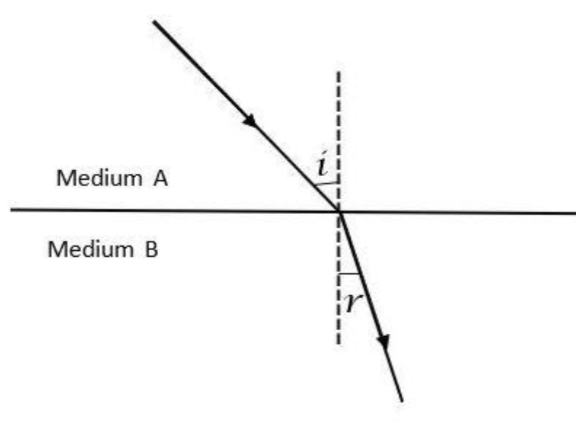
The ratio $\dfrac{\text{sin i}}{\text{sin r}}$ where $\angle i$ and $\angle r$ are the angles of incidence and refraction respectively is called the ______________________ of the second medium (B) with respect to the first medium (A).
A). Optical density
B). Power
C). Refractive Index
D). None
Answer
492.6k+ views
Hint: To solve this question, we need to know the basics of refraction. In refraction, the term refracting angle defines the angle that is in the middle of the refracted ray and the normal which is drawn at the point of incidence to the interface where refraction occurs. Keeping this in mind, we can easily solve the question given.
Complete step by step answer:
We should know that the ratio of the sine of the angle of incidence to the sine of the angle of refraction is Snell’s law. Brewster’s angle is an angle of incidence at which polarized light rays transmitted through a transparent dielectric surface, without any reflection.
In option A we have optical density. Optical density is defined as the degree to which a refractive medium retards transmitted rays of light. So, this does not match with the criteria mentioned in the question. Hence, this cannot be the answer.
In option B it is mentioned power. By power we mean, the amount of energy transferred or converted per unit time. So, this does not match with the criteria mentioned in the question. Hence, this cannot be the answer.
In option C, it is mentioned in the refractive index. We know that the refractive index is the ratio of the speed of light in two different mediums. This refers to the criteria mentioned in the question. It is also the ratio of the sine of the angle of incidence (i) and angle of refraction (r) and is given by $\mu =\dfrac{sini}{sinr}$. this can also be illustrated as follows;

So, this is the answer.
Hence, the correct answer is Option C.
Note: We must not confuse angle of refraction with the angle of reflection. Reflection does not depend on a medium while refraction depends on a medium. Even refraction can show properties of reflection at a specific angle.
Complete step by step answer:
We should know that the ratio of the sine of the angle of incidence to the sine of the angle of refraction is Snell’s law. Brewster’s angle is an angle of incidence at which polarized light rays transmitted through a transparent dielectric surface, without any reflection.
In option A we have optical density. Optical density is defined as the degree to which a refractive medium retards transmitted rays of light. So, this does not match with the criteria mentioned in the question. Hence, this cannot be the answer.
In option B it is mentioned power. By power we mean, the amount of energy transferred or converted per unit time. So, this does not match with the criteria mentioned in the question. Hence, this cannot be the answer.
In option C, it is mentioned in the refractive index. We know that the refractive index is the ratio of the speed of light in two different mediums. This refers to the criteria mentioned in the question. It is also the ratio of the sine of the angle of incidence (i) and angle of refraction (r) and is given by $\mu =\dfrac{sini}{sinr}$. this can also be illustrated as follows;

So, this is the answer.
Hence, the correct answer is Option C.
Note: We must not confuse angle of refraction with the angle of reflection. Reflection does not depend on a medium while refraction depends on a medium. Even refraction can show properties of reflection at a specific angle.
Recently Updated Pages
Master Class 10 General Knowledge: Engaging Questions & Answers for Success

Master Class 10 Computer Science: Engaging Questions & Answers for Success

Master Class 10 Science: Engaging Questions & Answers for Success

Master Class 10 Social Science: Engaging Questions & Answers for Success

Master Class 10 Maths: Engaging Questions & Answers for Success

Master Class 10 English: Engaging Questions & Answers for Success

Trending doubts
Name the place where the Indian National Congress session class 10 social science CBSE

Name the place where Indian National Congress session class 10 social science CBSE

Name the largest artificial lake that was built in class 10 social science CBSE

Truly whole mankind is one was declared by the Kannada class 10 social science CBSE

Explain the three major features of the shiwaliks class 10 social science CBSE

Removing barriers or restrictions set by the government class 10 social science CBSE




